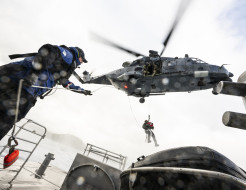
Wind and wet no barrier to RNZAF and police teamwork
31 March 2025
Unfortunately you are viewing this website on an outdated browser which does not support the necessary features for us to provide an adequate experience. Please switch to a modern browser such as latest version of Google Chrome, Mozilla Firefox, Apple Safari or Microsoft Edge.
Ngā mihi nui
Our size, skills, equipment and training means we're geared for combat. But when you’re as large as the Air Force, with highly skilled personnel and specialised assets, you end up being very valuable in other emergency situations.
The Air Force has around 2,500 personnel. It has disciplined forces and fleets of aircraft. Our resources are on a scale that civilian authorities can’t match; and the best thing about us is that we're available at short notice when a crisis happens, whether it's in New Zealand, or further afield with our Pacific neighbours.
Government agencies, such as the National Maritime Coordination Centre or the National Emergency Management Agency, will look at a situation, like a Mayday, a flood, or a fire, and ask themselves: what is the best way to solve this situation? When it’s on a large scale, or if it is remote and inaccessible, they may determine that the Air Force has the skills and equipment to respond to the situation.
A good example is search and rescue operations. The Royal New Zealand Air Force, at short notice, can put helicopters in the air, day or night, to search New Zealand’s rugged mainland, aided with sensory equipment to enhance the rescue operation. Similarly, we will despatch our P-3K2 Orion aircraft to search and locate missing boats on the ocean, even if they're hundreds of kilometres away.
We’ve joined forces with Fire and Emergency New Zealand to tackle large-scale forest fires, such as the Port Hills and Nelson fires in the past three years. When a community is flooded, our personnel rescue people, survey damage, and deliver Government assessment teams into affected areas.
The Air Force helped evacuate hundreds of tourists and New Zealanders from Kaikoura following an earthquake in 2016, as well as bring supplies into the cut-off township.
We help to ensure our fighting heritage – and the men and women who served during the two World Wars and other conflicts - is not forgotten. Our veterans and what they have done for New Zealand is important to the Air Force. We support the Returned and Services’ Association with commemorative events.
NZDF also works to support New Zealand’s youth because we are a progressive employer and keen to showcase what we can offer. The market for skilled youth is competitive, and we’d like New Zealand’s youngsters to see NZDF as a promising and fulfilling career. The Air Force runs an introduction programme for Year-13 girls who favour Science, Technology, Engineering and Mathematics.
Ultimately, the Air Force is a major New Zealand employer, providing New Zealanders with satisfying careers that support not only themselves, but the communities they live in. An Air Force base has hundreds of personnel who live and work on site, and this boosts local economies.
These area some of our stories
Our other areas of work